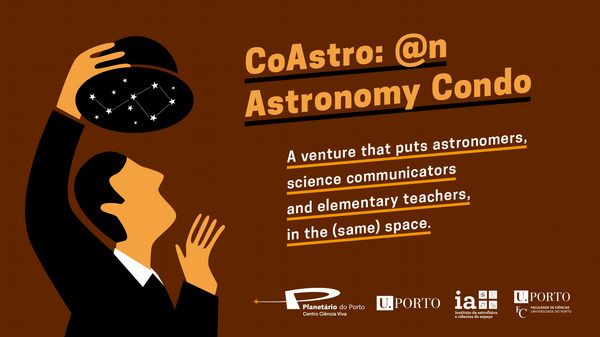
CoAstro: @n Astronomy Condo
Determination of the composition of stars; promote science dissemination
- Ongoing
More Information
In astronomy the main goal of the research is not, very often, its dissemination to the public. However, its social relevance should be one a starting point. For the public, neither the understanding of the results, nor the processes that led to them, are trivial tasks. This is even more relevant when there is a large increase in scientific production. One way to address this challenge, used by research institutes, is to produce press releases, hoping that social media will echo them. Although this formula has obvious advantages, its randomness and the short-term effect, for example, leads to several limitations and tends to have limited duration and reduced impact on the public lacking awareness of astronomy. Thus, there is an urgent need to create mechanisms / strategies that quickly disseminate results of scientific innovation without discouraging, in the process, the promotion of positive attitudes towards science and the nature of science itself. However, the question is how to do this with the limited human resources and funding normally associated with outreach. To respond to these challenges CoAstro emerged: a citizen science project that aimed the idealization, implementation and evaluation of a scientific dissemination mechanism that would allow the flow of results and scientific processes between researchers and the public, through the involvement of dissemination structures (already present in research institutes) and non-scientific participants (teachers).
The high scientific production in astronomy impel us to find new ways to carry out scientific dissemination of content, but also, of processes. Thus, we can promote positive attitudes towards science and the public can more easily deal with bad science, scientific fraud and fake news. In this context CoAstro: @n Astronomy Condo emerged – a citizen science project that directly connected four astronomers, nine elementary school teachers, four science disseminators and one mediator. CoAstro´s, whose first edition lasted an academic year, scientific content and processes were appropriated and integrated by teachers in school initiatives, reaching approximately one thousand people. Teachers’ involvement in astronomy research took place in two sub-projects: “Stars” and “Planets”. In the first, teachers analyzed standard stellar spectra that allow the qualitative and quantitative composition determination of 57000 stars. In addition, they determined star luminosity using Data Release 2 from the European Space Agency – ESA – GAIA Mission. In the planets project the team started with the production of a planetary transit video, through the Python program. Then, teachers analyzed curves to signal the presence of potential exoplanets. In the process, the mediator was integrated: he adapted the language and created “guidelines for research tasks”. He also ensured the maintenance of the collaborative work, articulating the challenges of research, dissemination and teaching. The scientific analysis of CoAstro’s results was achieved by implementing a qualitative research. The data were collected through questionnaires, interviews and observations. Results showed high improvements in teachers’ substantive and processual knowledge; positive change in epistemological attitudes and beliefs towards astronomy; as well as, the increasing of the quality of teachers’ scientific dissemination practices. Data from astronomers and disseminators, showed one main difference: science disseminators (unlike astronomers), have not changed their perception about teachers´ professional class, due to their participation in CoAstro. Indeed, both groups agree that the project: i) was useful (and facilitated) astronomy dissemination work; ii) it was an opportunity for teachers to increase their procedural knowledge about astronomy; iii) was, at the outset, risky, because of its idea of involving teachers in real astronomy research; iv) reinforced their own perception about the importance and purposes of dissemination practices, promoting new communication skills and new ways of structuring astronomy dissemination activities. Although with some implementation difficulties (time, adequacy of tasks …) CoAstro allowed us to understand how a citizen science project can contribute, with lasting and wide-public-ranging effects, to open the school to the surrounding community and vice-versa and how the public can open up to astronomy research and the latter to the public.
Ticket Required: No
Minimum Age: 13
Languages: English
